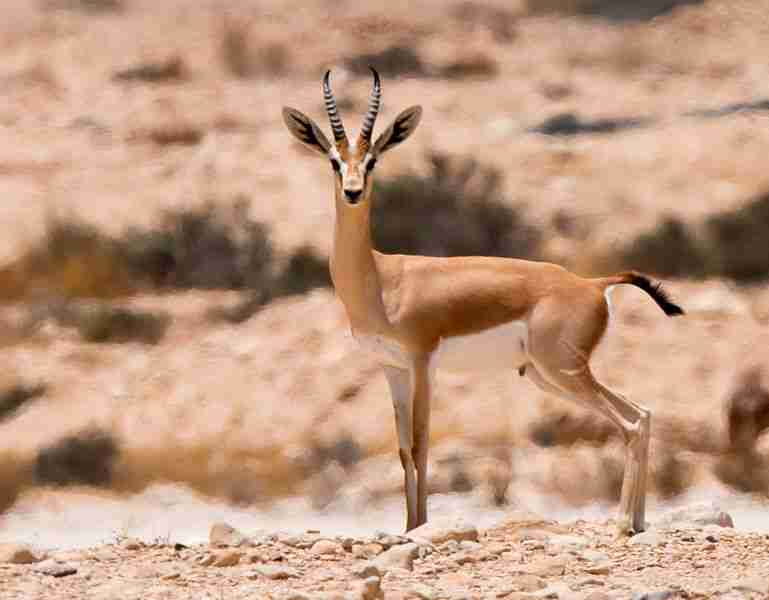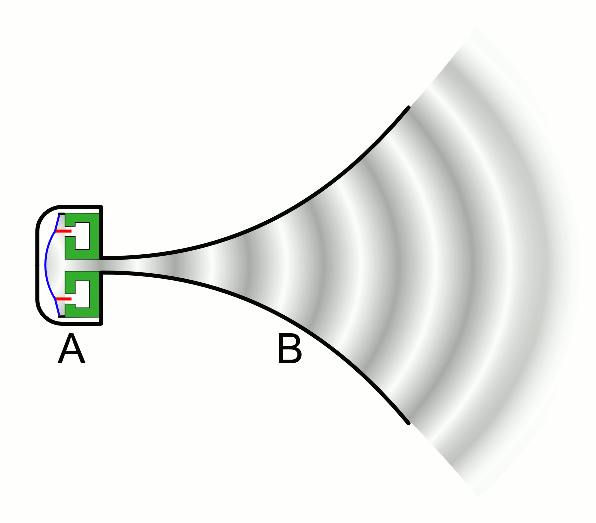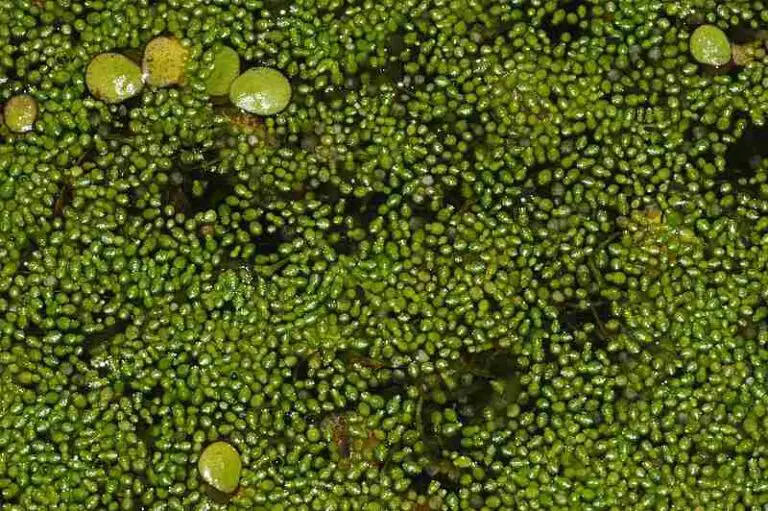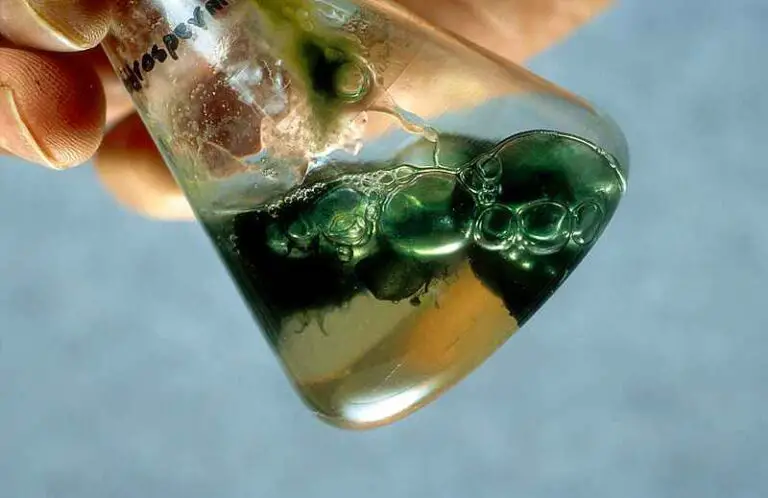Desert Food Web Based on Interconnections Between 5 Food Chains
Desert food web is a complex ecological model formed by the interrelations between producers and consumers from multiple trophic levels; which can be simplified by listing these organisms as part of individual food chains.
This article discusses desert food web based on five (5) desert food chains, as follows;
1). Food Chain 1 (as part of the Desert Food Web)
Below is a summary of the organic components of chain 1, which is part of the complex desert food web structure being discussed in this article;
Trophic Level 1: Yucca, marigold, buffalo grass
Trophic Level 2: Black-tailed jackrabbit, desert locust, kangaroo rat
Trophic Level 3: Fennec fox, hawk, caracal
Trophic Level 4: Eagle
In this food chain, each organism is confined to a specific trophic level that indicates its position in the energy-transfer succession, within the desert ecosystem.
Yucca, Marigold, Buffalo Grass (Trophic Level 1)
*Functions of Producers in Chain 1 of the Desert Food Web
Yucca, marigold, and buffalo grass are primary producers in the desert biome.
They are capable of utilizing solar radiation/sunlight, water, and carbon dioxide into organic biomass through photosynthesis.
They also provide energy and food for organisms in the higher trophic levels, and play a role in the sustainability and stability of the ecosystem.
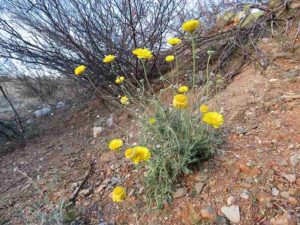
*Adaptations of Desert Producers
The plants in chain 1 of the desert food web, have adaptive features that enable them survive in arid conditions.
These features include;
1. Thick leaves with waxy cuticles for water conservation through reduced evapotranspiration [8]
2. Deep root systems for accessing and absorbing water at depth
3. Mechanisms to tolerate limited water availability and high temperatures (that is; drought conditions)
*Trophic Relationships
Desert producers are directly linked to primary consumers (herbivores), which directly feed on these plants for energy and nutrition.
This interaction (between producers and primary consumers in the desert) leads to the transfer of energy from trophic level 1 to trophic level 2.
Black-tailed Jackrabbit, Desert Locust, Kangaroo Rat (Trophic Level 2)
*Functions
The black-tailed jackrabbit, desert locust, and kangaroo rat are primary consumers in the desert food web (from chain 1), which feed mainly on vegetation (yucca, marigold, buffalo grass) that is present in the first trophic level.
As a result of their feeding activities, plant biomass is converted into nutrients and energy.
These herbivores also serve as a source of food for the next trophic level.
*Adaptations of Primary Consumers in the Desert Food Web (Chain 1)
Back-tailed jackrabbit possesses strong and relatively-long hind limbs [3], which it uses for rapid locomotion across the landscape, and to elude predators.

Desert locusts have well-adapted mouth parts including powerful mandibles for cutting through the thick tissues of desert plants.
Kangaroo rats possess specialized, efficient kidneys which minimize water loss to enable them survive in arid environments [12].
*Trophic Relationships
Black-tailed jackrabbit, desert locust, and kangaroo rat, all directly consume plant materials.
Also, secondary consumers (carnivores) in the next trophic level depend on the energy obtained from preying on these primary consumers.
Fennec Fox, Hawk, Caracal (Trophic Level 3)
*Functions of Secondary Consumers in the Desert Food Web (from Chain 1)
Fennec fox, hawk and caracal, prey directly on the primary consumers (black-tailed jackrabbit, desert locust, kangaroo rat). They obtain nutrients and energy from these herbivores which they consume.
*Adaptations
Fennec foxes possess large ears which enable them dissipate heat. Their hearing is also enhanced and plays a role in the detection and location of prey.
Hawks in the desert are equipped with keen eyesight, as well as sharp talons that they use for hunting.
Caracals are felines that may be found on the desert margin and in the savanna [6].
Their features include agility, keen senses, and muscular builds, all of which play a role in the capture of prey.

*Trophic Relationships
Secondary consumers (carnivores) in this trophic level, rely on the energy which they derive by preying upon the primary consumers. They also regulate the populations of these primary consumers through predation, and help maintain the equilibrium of their habitat.
Eagle (Trophic Level 4)
The eagle is the only tertiary consumer in the desert food web, from Chain 1. Below is a brief outline of its functions, adaptations and Trophic Relationships.
*Functions
The eagle functions as a tertiary consumer in this food chain, and occupies the apex trophic level.
While eagles are not core inhabitants of most deserts, they are highly versatile and may include deserts among the ecoregions which they traverse in search of food.
Eagles may prey on secondary consumers like juvenile fennec foxes and even hawks (compared to which they are superior as raptors), as well as on primary consumers like jackrabbits. This helps regulate the populations of these consumers.
*Adaptations
Eagles are equipped with curve-pointed beaks, sharp talons and keen eyesight, which enable them to capture and consume prey, including small mammals, reptiles and other birds in the desert ecosystem.
*Trophic Relationships
As an apex predator, the eagle significantly influences the trophic cascade within the desert food web.
Trophic cascade here refers to the influence which top predators have, both indirectly and directly on other consumers as well as producers in their environment [13].
The eagle helps to regulate organic populations in lower trophic levels, and plays a role to sustain the balance of bioenergy resources.
Contribution of Chain 1 Organisms to the Formation of the Desert Food Web
The formation of a complex food web in the desert ecosystem, relies on interactions and interlinks between organisms in the food chain.
Primary producers like yucca, marigold, and buffalo grass provide food and energy to primary consumers. These primary consumers, in turn provide resources to secondary consumers that prey on them.
Subsequently, the apex consumer(s) exert top-down influence on all lower levels of the chain through predation.
The food web is not confined to chain 1, but extends beyond it to organisms and trophic levels in other food chains. This is evident in the recurrence of multiple organisms like buffalo grass, caracal and hawk, in subsequent chains which will be discussed.
This interconnectedness reflects the intricate nature, interdependence and complexity of the desert ecosystem, with energy flowing through various organisms and trophic levels.
It also indicates that organisms can simultaneously play multiple (important) roles in maintaining the overall functionality and balance of the ecosystem.
2). Food Chain 2
Trophic Level 1: Creosote bush, cactus, sunflower, needlegrass
Trophic Level 2: Desert tortoise, Dorcas gazelle, desert gerbil
Trophic Level 3: Horned viper, owl, hawk
Trophic Level 4: African golden wolf, lappet-faced vulture, bacteria
Organisms in food chain 2 are specific in their role(s) trophic level of occupancy. The functions, adaptations, and trophic relationships of these organisms are discussed below:
Creosote Bush, Cactus, Sunflower, Needlegrass (Trophic Level 1)
*Functions
Creosote bush, cactus, sunflower and needlegrass are primary producers that capture and convert light from the Sun to biomass in the process of photosynthesis.
Because they provide energy and serve as sources of food for the higher trophic levels, these producers are essential to the desert biome.
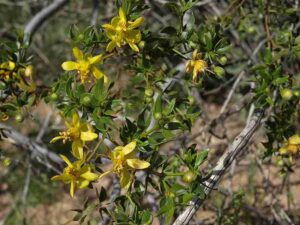
*Adaptations
These plants possess different adaptations for survival in arid terrains.
Creosote bushes develop waxy leaves for minimizing water loss.
Cacti plants are succulent; meaning they possess fleshy stems for storing water.
Sunflowers have deep roots that penetrate the soil in search of water and nutrients.
Needlegrass has narrow and elongate leaves for reduced water loss.
*Trophic Relationships
Primary consumers (herbivores) in the second trophic level rely on these plants for energy and sustenance.
Desert Tortoise, Dorcas Gazelle, Desert Gerbil (Trophic Level 2)
*Functions
Desert tortoise, Dorcas gazelle, and desert gerbil are primary consumers, and feed directly on plants from the first trophic level.
Through herbivorous feeding, they convert plant biomass into nutrients and energy for their survival. They also serve as a source of food for consumers in higher trophic levels.
*Adaptations
Desert tortoises possess scaly, thick skin, and are capable of storing water in their bladders [10].
Dorcas gazelles are known for their long limbs (for efficient locomotion in sandy terrain, and to elude predators). They also have efficient kidneys that help conserve water.

Adaptations of desert gerbils include moisture reabsorption (from food) capabilities, and burrowing behavior.
*Trophic Relationships
Desert tortoise, Dorcas gazelle, and desert gerbil are directly linked to producers which they feed on.
In turn, they provide energy to secondary consumers (carnivores) in the overlying trophic level, which prey on them.
Horned Viper, Owl, Hawk (Trophic Level 3)
*Functions
These organisms play the role of secondary consumers that survive mainly by preying on the primary consumers (desert tortoise, Dorcas gazelle, desert gerbil).
*Adaptations of Secondary Consumers in the Desert Food Web (from Chain 2)
Horned vipers possess color camouflage and venomous secretions through their fangs; both of which are used for hunting [1].
Desert owls have excellent vision in the dark, as well as silent flight that suits their nocturnal habits.
Hawks in the desert are equipped with keen eyesight and sharp talons to capture prey.
*Trophic Relationships
Secondary consumers regulate the populations of primary consumers and contribute to energy flow through predation.
Also, tertiary consumers (carnivores, omnivores) in the overlying trophic level rely on the energy obtained from consuming the secondary consumers.
African Golden Wolf, Lappet-faced Vulture, Bacteria (Trophic Level 4)
*Functions
These organisms are the tertiary consumers in the food chain.
African golden wolves prey on herbivores like gazelle, and can also feed on smaller predators.
Lappet-faced vultures are classified as tertiary consumers because they are scavengers, which feed on carrion of organisms from all levels of the food chain.
Bacteria is one of the decomposers in the desert; which are not confined to any particular trophic level.
This means that it can cause the biodegradation of organic matter from plants, as well as from primary, secondary and tertiary consumers.
*Adaptations
African golden wolves possess strong jaws and sharp teeth which they use to capture and consume prey.
Features of lappet-faced vultures include strong beaks for tearing animal carcasses.

Bacteria are equipped with effective, digestive possess enzymes which are used to break down organic matter.
*Trophic Relationships
The tertiary consumers contribute to overall energy flow by preying on other consumers at lower trophic levels. They may also participate in the decomposition process by acting as scavengers.
*Formation of the Food Web
Producers and consumers in this food chain are interconnected across the various trophic levels, thereby forming a complex ecological network known as the desert food web.
Plants (creosote bush, cactus, sunflower, needlegrass) function as the primary producers, and provide energy to the primary consumers (desert tortoise, Dorcas gazelle, desert gerbil).
In turn, these primary consumers serve as sources of food for the secondary consumers (horned viper, owl, hawk), causing energy to flow up the trophic levels.
The tertiary consumers (African golden wolf, lappet-faced vulture) complete the chain by preying on lower (primary and secondary) consumers.
Bacteria is a decomposer that plays a crucial role in breaking down organic matter and recycling used nutrients back into the ecosystem, for re-use.
Recurring Organisms from Preceding Chains
1. Hawk is a secondary consumers also in Chain 1
3). Food Chain 3 (as part of the Desert Food Web)
Trophic Level 1: Marigold, yucca, mesquite, buffalo grass
Trophic Level 2: Black-tailed jackrabbit, dromedary camel, desert gerbil
Trophic Level 3: Sand boa, desert monitor lizard, owl
Trophic Level 4: Caracal, eagle
In food chain 3, each organism is distinct in its role(s), and also occupies a distinct trophic level. The functions, adaptations, and trophic relationships of the organisms in this chain are discussed below;
Marigold, Yucca, Mesquite, Buffalo Grass (Trophic Level 1)
*Functions of Producers in Chain 3 of the Desert Food Web
These organisms are autotrophic producers that transform abiotic raw materials including sunlight, carbon dioxide and water, into organic compounds; through photosynthesis.
They serve as food and energy sources for organisms in the higher trophic levels.
*Adaptations
These desert plants have diverse adaptations to survive in their habitat.
Marigolds and yuccas have deep roots for access to water at depth.
Mesquite trees also have long taproots used to reach groundwater.
Buffalo grass has physiological characteristics that make it drought-tolerant.
*Trophic Relationships
The primary consumers (herbivores) in the second trophic level rely on these plants for energy transfer, and sustenance.
Black-tailed Jackrabbit, Dromedary Camel, Desert Gerbil (Trophic Level 2)
*Functions
Black-tailed jackrabbit, dromedary camel and desert gerbil are all primary consumers that directly feed on plant materials from the first trophic level.
In the process, they transform plant biomass into nutrients and energy that they assimilate, and act as a source of food for organisms in the next trophic level.
*Adaptations of Primary Consumers in Chain 3 of the Desert Food Web
Black-tailed jackrabbits possess powerful hind legs for running, as well as long ears for heat-dissipation and thermoregulation [5].
Dromedary camels have humps which are used for storage of store fat and conservation of water.
Desert gerbils have developed an efficient renal system to conserve water through production of concentrated urine [11].
*Trophic Relationships
Primary consumers survive by feeding on plants (producers), which the omnivorous members of this category may supplement with other forms of biomass.
The secondary consumers (carnivores and omnivores) in the overlying trophic level, obtain their own energy by feed mainly on these primary consumers.
Sand Boa, Desert Monitor Lizard, Owl (Trophic Level 3)
*Functions
These organisms are all secondary consumers, and prey on the primary consumers (black-tailed jackrabbit, dromedary camel, desert gerbil) in the food chain.
They are mostly carnivorous, and derive nutrients and energy from consuming the herbivores.
*Adaptations
Sand boas are capable of burrowing, and can ambush prey.
Desert monitor lizards possess powerful jaws and sharp claws which they use for hunting and feeding.

Owls are equipped with noiseless flight capability, and excellent night vision to locate and capture their prey.
*Trophic Relationships
Secondary consumers contribute to upward energy flow by consuming primary producers like herbivorous rodents.
In the desert energy pyramid, it is shown that the amount of bioenergy decreases by 90% in each upward transfer from one trophic level to another; in what is often described as the effect of trophic transfer efficiency (TTE).
Tertiary consumers can prey on these secondary consumers.
Caracal, Eagle (Trophic Level 4)
*Functions of Tertiary Consumers in Chain 3 of the Desert Food Web
Organisms listed tor trophic level 4 in the above heading, represent the tertiary consumers in this food chain.
Caracals and eagles have biological advantages that enable them consume small mammals and other carnivores, while remaining themselves less-vulnerable to predation. Their activities contribute to the control of overpopulation (where organisms exceed available resources in the desert) and the transfer of energy.
*Adaptations
Caracals possess tufted eats for enhanced hearing, to detect prey or potential danger.
They also have long limbs and sharp teeth for pursuing, capturing and consuming prey.
Eagles have curved, pointed beaks as well as talons for capturing and consuming their prey. Their wings are also powerful and they posses excellent flight capability which enables them carry prey that are too heavy for most raptors.
*Trophic Relationships
These tertiary consumers complete the food chain by preying on other consumers in lower trophic levels.
For example, eagles can prey on sand boas, and black-tailed jackrabbit; caracal can prey on owls, gerbils and jackrabbits. They contribute to ecological stability through the trophic cascade effect.
*Formation of the Food Web
The organisms food chain 3, contribute to the formation of a complex desert food web.
Primary producers provide energy from sunlight, which is then transferred through grazing, to the primary consumers.
The secondary consumers (carnivores and omnivores) consume primary consumers, and the tertiary consumers prey on other consumers in lower trophic levels.
Decomposers, like bacteria and fungi, help degrade waste-organic matter, thereby recycling nutrients back into the ecosystem. This ensures continuous flow of energy and cycling of nutrients.
Some organisms in food chain 3 link out to other food chains (1, 2, 4, 5) by means of ecologic roles which they also play in these chains. Such inter-chain links build-out to form a multidimensional and complex structure known as the food web. This is proven in the section below, which lists some recurring organisms from previous food chains, in chain 3.
*Recurring Organisms
1. Yucca plant and buffalo grass are also producers in Chain 1
2. Desert gerbil can be found in Chain 2
3. Black-tailed jackrabbit occurs in Chain 1
4. Owl is a secondary consumer also in Chain 2
5. Caracal occurs as a secondary consumer in Chain 1, while it is a tertiary consumer in Chain 3. This multi-level occurrence indicates the complexity of trophic roles and relationships, and how these are capable of creating multiple connections across the ecosystem to for a food web
6. Eagle is also an apex predator (trophic level 5: quaternary) in Chain 1. In Chain 3 it occurs in trophic level 4 as a tertiary consumer
4). Food Chain 4
Trophic Level 1: Needlegrass, creosote bush, sunflower
Trophic Level 2: Desert locust, desert gerbil
Trophic Level 3: Hawk, rattlesnake, coyote
Trophic Level 4: Bobcat, golden eagle
Needlegrass, Creosote Bush, Sunflower (Trophic Level 1)
*Functions of Producers in Chain 4 of the Desert Food Web
Needlegrass, creosote bush and sunflower are plants which convert sunlight to chemical energy in the process of photosynthesis. They support the entire food chain by serving as initial suppliers of energy.
*Adaptations
Needlegrass possesses narrow and long leaves for minimizing water loss.
Creosote bush possesses waxy leaves which enable the plant to conserve water.
Sunflowers produce large, brightly-colored flowers that attract pollinators like insects and some birds, in the desert [9].
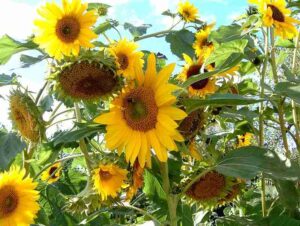
*Trophic Relationships
These plants are food for primary consumers in the second trophic level, which depend on then for food. Plant-derived energy is transferred up the food chain by primary consumers that feed on plants.
Desert Locust, Desert Gerbil (Trophic Level 2)
*Functions of Primary Consumers in Chain 4 of the Desert Food Web
Desert locust, and desert gerbil are primary consumers that directly consume plant matter from the first trophic level.
They help transform biomass from plants into nutrients and energy, and transfer this resources further up the chain structure, by serving as prey for the overlying trophic level.
*Adaptations
Desert locusts have digestive and oral adaptations for consuming desert vegetation.
They also posses strong, extensive hind legs for jumping, and they reproduce very rapidly, so that they form large swarms when food is sufficiently available. This attribute makes them formidable as plant pests in any habitat [4].
Desert gerbils possess efficient kidneys for conserving water. While they do not have cheek pouches for hoarding and conveying food, they are still able to carry food materials for storage.
*Trophic Relationships
These primary consumers enable secondary consumers in the third trophic level to obtain energy by serving as prey for the latter.
Hawk, Rattlesnake, Coyote (Trophic Level 3)
*Functions
Hawk, rattlesnake and coyote are secondary consumers that occur especially in arid (and semiarid) parts of North America.
They prey on the primary consumers (including desert locust and desert gerbil), deriving nutrients and energy from these herbivores.
*Adaptations
Hawks have talons and sharp beaks for capturing and consuming their prey.
Rattlesnakes are equipped with venomous fangs which they use to subdue their prey.
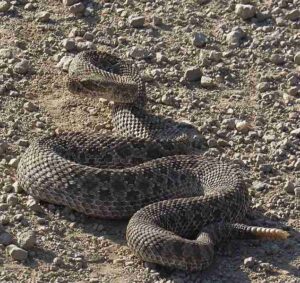
Coyotes are very resilient and versatile, possessing keen senses and good hunting skills. Due to their versatility, coyotes also excel in several other habitats, such as prairies, temperate forests, and even urban areas [7].
*Trophic Relationships
Tertiary consumers in the fourth trophic level may prey on some secondary consumers in addition to primary consumers.
Bobcat, Golden Eagle (Trophic Level 4)
*Functions of Tertiary Consumers from Chain 4, in the Desert Food Web
Bobcat and golden eagle represent the tertiary consumers in the food chain.
Both animals are predatory, and consume other carnivores including reptiles and small mammals. Their activities contribute to population-regulation and energy transfer.
*Adaptation(s) of Tertiary Consumers in the Desert Food Web from Chain 4
Bobcats are formidable predators with agility, stealth, sharp claws and teeth, while golden eagles have sharp beaks, talons and powerful wings for capturing and carrying their prey.
*Trophic Relationships
The tertiary consumers play an important role in regulation of lower trophic populations, and contribute to the overall stability of the desert biome.
*Formation of the Food Web
Food chain 4 is one of several linear ecologic models that form the building blocks of a more extensive and complex food web in the desert ecosystem.
Primary producers (plants) provide energy to primary consumers, which in turn serve as food for secondary and tertiary consumers. The tertiary consumers, such as bobcats and golden eagles, play a key role in controlling the population of organisms in lower trophic levels, thereby maintaining balance of resources within the biome.
The main links that form the network known as desert food web; occurs due to the recurrence of organisms in different food chains and trophic levels. Such organisms can also be found in Chain 4, as listed below;
*Recurring Organisms from Preceding Food Chains
1. Creosote bush is also a producer in Chain 2, alongside sunflower and needlegrass
2. Desert locust can be found functioning as a primary consumer in Chain 1
3. Desert gerbil occurs in Chains 2 and 3
4. Hawk is a secondary consumer also in Chains 1 and 2
5. The eagle can be found in Chains 1 and 3 (levels 5 and 4 respectively)
5). Food Chain 5 (as part of the Desert Food Web)
Trophic Level 1: Acacia, mesquite, buffalo grass, marigold
Trophic Level 2: Dorcas gazelle, dromedary camel, desert tortoise, jackrabbit
Trophic Level 3: Sand fox, hawk, sand boa
Trophic Level 4: Mulga snake, caracal, lappet-faced vulture
Acacia, Mesquite, Buffalo Grass, Marigold (Trophic Level 1)
*Functions
These plants play the role of primary producers in the food chain, by converting sunlight into chemical energy for animal consumption. They are sources of food and micro-habitat for a variety of desert organisms.
*Adaptations
Acacias possess thorns for defense against herbivores [2].
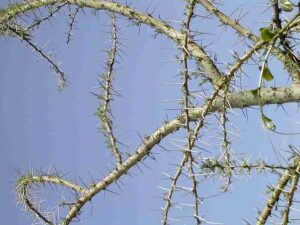
Mesquite trees possess deep roots which improves its access to water.
Buffalo grass also has a deep root system for water access/absorption, while marigolds produce bright flowers to attract pollinators.
*Trophic Relationships
Producers share a direct trophic relationship with primary consumers in the second trophic level, which depend on these plants for food. Their relationship ensures that energy flows up the food chain.
Dorcas Gazelle, Dromedary Camel, Desert Tortoise, Jackrabbit (Trophic Level 2)
*Functions of Primary Consumers in Chain 5 of the Desert Food Web
Dorcas gazelle, dromedary camel, desert tortoise and jackrabbit are all primary consumers that feed directly on desert vegetation from the first trophic level.
They play their role in energy transfer by converting plant biomass into nutrients and energy that can be assimilated by higher organisms through feeding.
*Adaptations
Dorcas gazelles have long limbs, as well as specialized kidneys for concentrated urine production and water conservation.
Dromedary camels have humps that are used for storing fat reserves.
Desert tortoises are drought-tolerant, and can extract water from ingested plant materials.
Jackrabbits have camouflage, drought-tolerance, and powerful limbs for fast running, to escape predators.
*Trophic Relationships
As primary consumers, these organisms are trophically linked to both producers and secondary consumers.
They derive energy from producers on which they feed; and supply energy to secondary consumers which prey on them.
Their waste and remains are sources of nourishment to decomposers like bacteria and fungi, which breakdown such materials and play a role in both soil conservation and resource-recycling.
Sand Fox, Hawk, Sand Boa (Trophic Level 3)
*Functions
Sand fox, hawk and sand boa boa are secondary consumers in the desert, which are capable of preying on some of the primary consumers (like Dorcas gazelle, dromedary camel, desert tortoise, and jackrabbit).
By consuming herbivores, they contribute to the flow of energy across the desert food web/chain.
*Adaptations
Sand foxes possess agility and keen senses for hunting.
Hawks have sharp beaks, keen eyesight and talons for capturing their prey from the ground or air.
Sand boas have short, muscular bodies which they use to constrict prey.
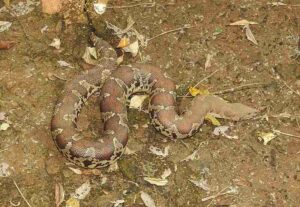
*Trophic Relationships
Secondary consumers interact with primary consumers and tertiary consumers, as potential food sources and prey, respectively.
Mulga Snake, Caracal, Lappet-faced Vulture (Trophic Level 4)
*Functions of Tertiary Consumers in Chain 5 of the Desert Food Web
Mulga snake, caracal and lappet-faced vulture have peculiarities that place them above other organisms as tertiary consumers in the desert.
They are at the apex of the food chain/energy pyramid, from where they contribute to the trophic cascade effect and control the populations of lower organisms.
*Adaptations
Mulga snakes are larger than most snakes in the desert. They are capable of inflicting venomous bites to paralyze and subdue their prey.
Caracals have claws and sharp teeth for hunting.
Lappet-faced vultures have strong beaks and digestive systems for feeding on carrion.
*Trophic Relationships
From their apex position, tertiary consumers in the desert play an effective role in population control.
Among the animals in this trophic level for Chain 5, the lappet-faced vulture is considered a tertiary consumer because its scavenging behavior enables it to feed on the remains of consumers from any trophic level.
Formation of the Desert Food Web
The interconnectedness of organisms from different food chains forms a complex food web in the desert biome.
Primary producers, such as acacias, mesquite, buffalo grass, and marigolds, support the primary consumers, which are subsequently preyed upon by secondary and tertiary consumers.
The tertiary consumers, such as mulga snakes, caracals, and lappet-faced vultures, play a crucial role in maintaining balance by controlling the populations of organisms in lower trophic levels.
*Recurring Organisms from Preceding Food Chains that Link Outward to Form the Desert Food Web
1. Mesquite also occurs in Chain 3
2. Buffalo grass can be found as a producer in Chains 1 and 3
3. Marigold is also a producer in Chains 1 and 3
4. Dorcas gazelle occurs in Chain 2 as a primary consumer
5. Dromedary camel is found also in Chain 3
6. Desert tortoise occurs in Chain 2
7. Jackrabbit is also a primary consumer in Chain s 1 and 3
6. Hawk occurs in Chains 1, 2 and 4
7. Sand boa can be found also as a secondary consumer in Chain 3
8. Caracal is a secondary consumer in Chain 1 and a tertiary consumer in Chain 3
9. Lappet-faced vulture also occurs in Chain 2 as a tertiary consumer
Conclusion
The desert food web is built upon complex relations between different organisms involved in the transfer of bioenergy through feeding, in arid regions.
For simplicity, these organisms can be presented as part of defined linear chains from which they link out to other chains and form interconnected trophic networks.
The existence of such networks is evident in the recurrence of organisms in more than one food chain and/or trophic level; as can be seen in the hypothetical food chains below;
Food Chain 1: Yucca, marigold, buffalo grass (Trophic Level 1)→black-tailed jackrabbit, desert locust, kangaroo rat (Trophic Level 2)→fennec fox, hawk, caracal (Trophic Level 3)→eagle (Trophic Level 4)
Food Chain 2: Creosote bush, cactus, sunflower, needlegrass (Trophic Level 1)→desert tortoise, Dorcas gazelle, desert gerbil (Trophic Level 2)→horned viper, owl, hawk (Trophic Level 3)→African golden wolf, lappet-faced vulture, bacteria (Trophic Level 4)
Food Chain 3: Marigold, yucca, mesquite, buffalo grass (Trophic Level 1)→black-tailed jackrabbit, dromedary camel, desert gerbil (Trophic Level 2)→sand boa, desert monitor lizard, owl (Trophic Level 3)→caracal, eagle (Trophic Level 4)
Food Chain 4: Needlegrass, creosote bush, sunflower (Trophic Level 1)→desert locust, desert gerbil (Trophic Level 2)→hawk, rattlesnake, coyote (Trophic Level 3)→bobcat, golden eagle (Trophic Level 4)
Food Chain 5: Acacia, mesquite, buffalo grass, marigold (Trophic Level 1)→Dorcas gazelle, dromedary camel, desert tortoise, jackrabbit (Trophic Level 2)→sand fox, hawk, sand boa (Trophic Level 3)→mulga snake, caracal, lappet-faced vulture (Trophic Level 4)
References
1). Al-Sadoon, M. K.; Paray, B. A. (2016). "Ecological Aspects of the Horned viper, Cerastes cerastes gasperettii in the Central Region of Saudi Arabia." Saudi Journal of Biological Sciences 23(1). Available at: https://doi.org/10.1016/j.sjbs.2015.10.010. (Accessed 6 July 2023).
2). Brooks, R.; Owen-Smith, N. (1994). "Plant defences against mammalian herbivores: Are juvenile Acacia more heavily defended than mature trees?" Bothalia - African Biodiversity and Conservation 24(2). Available at: https://doi.org/10.4102/abc.v24i2.773. (Accessed 6 July 2023).
3). Carrier, D. (1995). "Ontogeny of jumping performance in the black-tailed jackrabbit (Lepus californicus)." Zoology 98:309-313. Available at: https://www.researchgate.net/publication/284772783_Ontogeny_of_jumping_performance_in_the_black-tailed_jackrabbit_Lepus_californicus. (Accessed 6 July 2023).
4). Cressman, K. (2016). "Desert Locust." Biological and Environmental Hazards, Risks, and Disasters (pp.87-105). Available at: https://doi.org/10.1016/B978-0-12-394847-2.00006-1. (Accessed 6 July 2023).
5). Dawson, T.; Schmidt-Nielsen, K. (1966). "Effect of thermal conductance on water economy in the antelope jack rabbit, Lepus alleni." J Cell Physiol. 1966 Jun;67(3):463-71. Available at: https://doi.org/10.1002/jcp.1040670311. (Accessed 6 June 2023).
6). Dobamo, T. (2019). "Ecology of Caracals and Their Distribution in Africa: A Review Paper." Journal of Biology, Agriculture and Healthcare Vol 9, No 13 (2019). Available at: https://doi.org/10.7176/JBAH/9-13-05. (Accessed 6 July 2023).
7). Gehrt, S.; Anchor, C.; White, L. (2009). "Home Range and Landscape Use of Coyotes in a Metropolitan Landscape: Conflict or Coexistence?" Journal of Mammalogy 90(5):1045-1057. Available at: https://doi.org/10.1644/08-MAMM-A-277.1. (Accessed 6 July 2023).
8). Mohanta, T. K.; Mohanta, Y. K.; Kaushik, P.; Kumar, J. (2023). "Physiology, genomics, and evolutionary aspects of desert plants." J Adv Res. 2023 May 7:S2090-1232(23)00125-X. Available at: https://doi.org/10.1016/j.jare.2023.04.019. (Accessed 6 July 2023).
9). Muhammad, W.; Saeed, S.; Ahmad, A.; Ishfaq, M. M.; Anjum, M. M.; Khan, I. (2021). "Pollinator community of sunflower (Helianthus annus L.) and its role in crop reproductive success." Available at: https://www.semanticscholar.org/paper/Pollinator-Community-of-Sunflower-(Helianthus-annus-Muhammad/a76022a69c11d98ed98e987be5bea4a2d7766f88. (Accessed 6 July 2023).
10). Peterson, C. C. (1996). "Anhomeostasis: Seasonal Water and Solute Relations in Two Populations of the Desert Tortoise (Gopherus agassizii) during Chronic Drought." Physiological Zoology, Vol. 69, No. 6 (Nov. - Dec., 1996), pp. 1324-1358. Available at: https://www.journals.uchicago.edu/doi/abs/10.1086/physzool.69.6.30164263. (Accessed 6 July 2023).
11). Sasidharan, T. O.; Goyal, S. P.; Chand, P.; Ghosh, P. K. (1990). "The effects of water deprivation and salt load on water conservation efficiency in two Indian desert gerbils." J Comp Physiol B. 1990;160(4):413-22. Available at: https://doi.org/10.1007/BF01075673. (Accessed 6 July 2023).
12). Vimtrup, B.; Schmidt-Nielsen, B. (1952). "The histology of the kidney of kangaroo rats." Anat Rec. 1952 Dec;114(4):515-28. Available at: https://doi.org/10.1002/ar.1091140402. (Accessed 6 July 2023).
13). Wallach, A. D.; Ripple, W. J.; Carroll, S. P. (2015). "Novel trophic cascades: apex predators enable coexistence." Trends Ecol Evol. 2015 Mar;30(3):146-53. Available at: https://doi.org/10.1016/j.tree.2015.01.003. (Accessed 6 July 2023).
